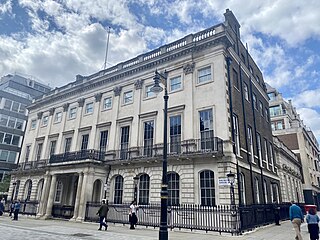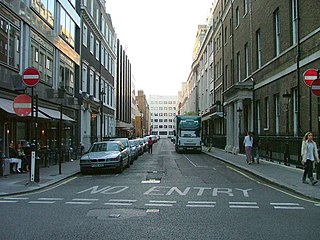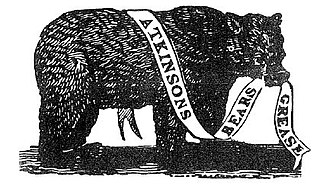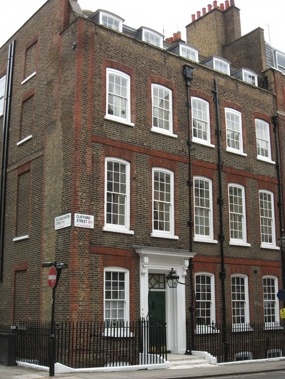
Burlington Gardens is a street in central London, on land that was once part of the Burlington Estate. [1]

Burlington Gardens is a street in central London, on land that was once part of the Burlington Estate. [1]

The street is immediately to the north of the Royal Academy of Arts [2] and joins Old Bond Street and New Bond Street in the west and Vigo Street in the east. Cork Street, Savile Row and Old Burlington Street all run north from Burlington Gardens.
On the south side of Burlington Gardens is one end of the Burlington Arcade and the rear of Albany at 10 and 12 Burlington Gardens, which is wedged between the end of Burlington Gardens and the start of Vigo Street. This part of Albany was designed by Henry Holland. [3]
Burlington Gardens was once part of Vigo Lane (later renamed Vigo Street) which originally ran all the way from Bond Street to Glasshouse Street before the part behind Burlington House was renamed Burlington Gardens [4] by 1831. [5]
And before it was either Vigo Street or Lane, the whole roadway from what is now Bond Street to the current Glasshouse Street was called Glasshouse Street. [5]

Burlington Gardens contains a number of historic buildings. Both number six and number seven are Grade II* listed by English Heritage. [6]
Atkinsons Building, which includes 2 and 4 Burlington Gardens, is on the corner of Old Bond Street and Burlington Gardens. It was built in 1926 in the Gothic Revival style and includes Arts and Crafts detailing. It is Grade II-listed by English Heritage. [7]
6 Burlington Gardens is used by the Royal Academy and is the largest building in the street. It was built in 1866–67 on the garden of Burlington House to a design by Sir James Pennethorne. [8] It was originally the headquarters of the University of London. From 1900 it was occupied by the Civil Service Commission. It then became the Museum of Mankind before being taken over by the Royal Academy. [1] It has an Italianate facade, and the portico includes four statues by Joseph Durham of Newton, Bentham, Milton and Harvey, representing Science, Law, Arts and Medicine. [8]
7 Burlington Gardens is on the north side of the street and was built in 1721–23 to designs by the Italian architect Giacomo Leoni. It was first occupied by the Duke of Queensberry, and the poet John Gay also lived there. It was originally known as Queensberry House, but became Uxbridge House after the Earl of Uxbridge bought it in 1785. From 1785–89, it was extended by the architects John Vardy the Younger and Joseph Bonomi the Elder for Lord Uxbridge. [9] It later became home to the Marquess of Anglesey, the Bank of England and the Royal Bank of Scotland. [1] It was an Abercrombie & Fitch store, the first in Europe. [10] [11]

William Kent was an English architect, landscape architect, painter and furniture designer of the early 18th century. He began his career as a painter, and became Principal Painter in Ordinary or court painter, but his real talent was for design in various media.

Sir James Pennethorne was a British architect and planner, particularly associated with buildings and parks in central London.

Savile Row is a street in Mayfair, central London. Known principally for its traditional bespoke tailoring for men, the street has had a varied history that has included accommodating the headquarters of the Royal Geographical Society at 1 Savile Row, where significant British explorations to Africa and the South Pole were planned; and more recently, the Apple office of the Beatles at 3 Savile Row, where the band's final live performance was held on the roof of the building.

Burlington House is a building on Piccadilly in Mayfair, London. It was originally a private English Baroque and then Neo-Palladian mansion owned by the Earls of Burlington. It was significantly expanded in the mid-19th century after being purchased by the British government. Today, the Royal Academy and five learned societies occupy much of the building.

Carlton House Terrace is a street in the St James's district of the City of Westminster in London. Its principal architectural feature is a pair of terraces, the Western and Eastern terraces, of white stucco-faced houses on the south side of the street, which overlook The Mall and St. James's Park. These terraces were built on Crown land between 1827 and 1832 to overall designs by John Nash, but with detailed input by other architects including Decimus Burton. Construction was overseen by James Pennethorne. Both terrace blocks are Grade I listed buildings. A separate but linked cul-de-sac at the terrace's western end is named Carlton Gardens.

6 Burlington Gardens is a Grade II*-listed building in Mayfair, London. Built for the University of London, it has been used by various institutions in the course of its history, including the Civil Service Commission, the British Museum and, currently, the Royal Academy of Arts.

Hampton Hill is a district in the London Borough of Richmond upon Thames to the south of Twickenham. It is bounded by Fulwell and Twickenham Golf Courses to the northwest; a railway line road bridge at the junction of Wellington Road and Clonmel Road; a line southward just east of Wellington Road; Bushy Park to the southeast; and the artificial Longford River to the south and west. Hampton Hill is served by Fulwell railway station and Hampton railway station on the Shepperton to Waterloo line. It is part of what is collectively known as The Hamptons. Much of Hampton Hill High Street, and some neighbouring residential areas are designated as a conservation area.

Ede & Ravenscroft are the oldest tailors in London, established in 1689. They have two London premises, in Chancery Lane and Burlington Gardens, very close to the famous Savile Row. They make, sell and hire out legal gowns and wigs, clerical dress, civic and municipal robes, academic dress and other ceremonial and formal dress, and have shops in Oxford, Cambridge and Edinburgh.

Cork Street is a street in Mayfair in the West End of London, England, with many contemporary art galleries, and was previously associated with the tailoring industry.

Abercrombie & Fitch Co. (A&F) is an American lifestyle retailer that focuses on contemporary clothing. Its headquarters are in New Albany, Ohio. The company operates three offshoot brands: Abercrombie Kids, Hollister Co., and Gilly Hicks. As of February 2020, the company operated 854 stores across all its brands.

7 Burlington Gardens is a Grade II* building in Mayfair, London. Formerly known as Queensberry House, it was later called Uxbridge House. The building was a bank for much of the 19th and 20th centuries, and was later for a time home to the London flagship store of the American fashion retailer Abercrombie & Fitch.
John Vardy was an English architect attached to the Royal Office of Works from 1736. He was a close follower of the neo-Palladian architect William Kent.
Rupert William Lycett Green is a British fashion designer known for his contribution to 1960s male fashion through his tailor's shop/boutique Blades in London.

Vigo Street is a short street in central London that is named after the Anglo-Dutch naval victory over the French and Spanish in the 1702 Battle of Vigo Bay. It has important literary connections.

Old Burlington Street is a street in central London that is on land that was once part of the Burlington Estate.

Atkinsons Building, which includes 2 and 4 Burlington Gardens, is a Grade II listed building on the corner of Old Bond Street and Burlington Gardens. It was built in 1926 in the Gothic Revival style and includes Arts and Crafts detailing.

Atkinsons of London is a British perfume house founded in London in 1799. The brand was relaunched in September 2013 after a long dormant period off the market.

Clifford Street is a street in central London, built in the early 18th century, on land that once formed part of the Burlington Estate. It is named after the Clifford family, Earls of Cumberland. The daughter and heiress of the last holder of that title was the mother of the first Lord Burlington.

A statue of Sir Joshua Reynolds stands in the Annenberg Courtyard of Burlington House, off Piccadilly in the City of Westminster, London, England. Reynolds was the first president of the Royal Academy, who occupy the main wing of Burlington House.